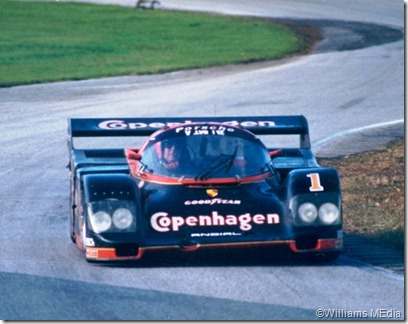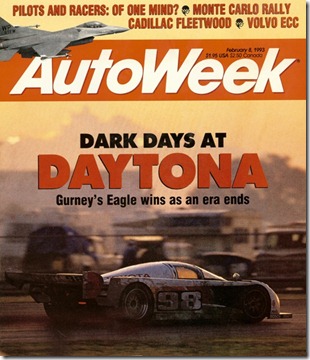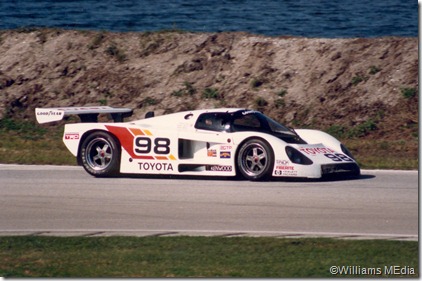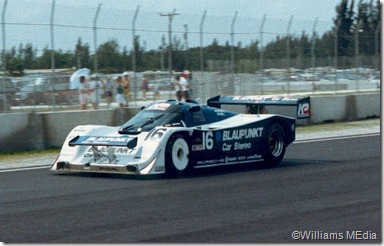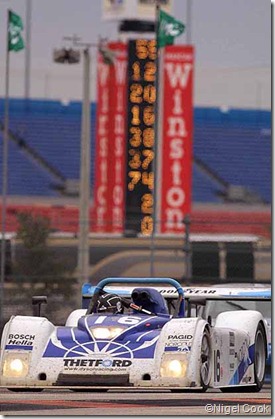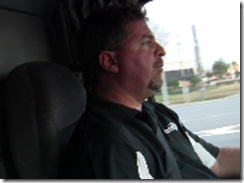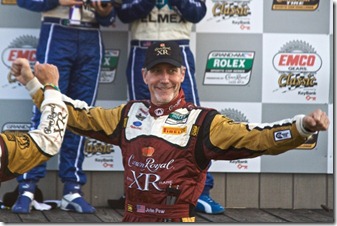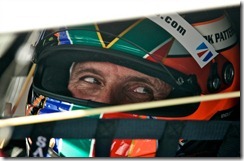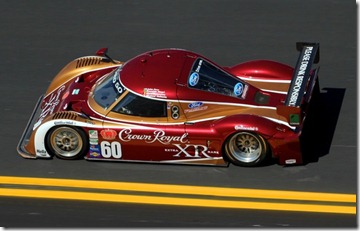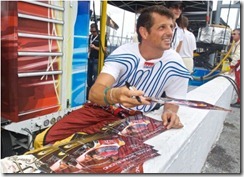As fast as newswires and voices on the wind could carry it on Oct. 17, 2000, the world learned, some might say “shocked,” when it was announced that Dale Earnhardt and son Dale Earnhardt Jr. would team in a Corvette C5.R with driver Andy Pilgrim for the Feb. 3-4, 2001, Rolex 24 At Daytona.
Before the announcement and even though in the wake of yet another outstanding Earnhardt performance the previous day at Talladega Superspeedway – where the seven-time Cup champion driver had simultaneously emerged from 18th place and the midst of another “Big One” to claim his 10th win on the 2.66-mile tri-oval – skeptical were some of the media members gathered in Earnhardt’s (Richard Childress Racing) Mooresville, N.C., race shop for that announcement.
Though the Talladega win allowed Earnhardt to advance into second place in the (then) Winston Cup championship standings, many in attendance had beforehand expected the “special” announcement would be little more than another exploitable means by which the team could extol the virtues of one or more sponsors.
Besides, with only four races remaining in the season and 210 points to overcome at the time, it seemed improbable anyone would seriously suggest Earnhardt might wrestle the Winston Cup championship from the grasp of points leader Bobby Labonte.
Still, when Earnhardt “invited” . . .
As the media dutifully gathered – some grumbling because of a lost day off – most of those who had returned in time from Talladega wondered what possibly could be so important, whatever it may be, that it couldn’t have awaited the weekend’s Rockingham race.
Walking through the designated meeting room doors would only add to reporters’ curiosity, if not confusion.
Up front and “onstage” in the glare of video lights as each blazed to life, Pilgrim was feeling a bit uncomfortable.
As though a fish fresh out of water, Pilgrim felt the hot sting of reporters’ glares boring through him, each wondering, “Who is this guy and what is he doing here?”
It wasn’t so much that Pilgrim was at all unfamiliar or uncomfortable with being in the limelight. After all, he was an accomplished sportscar driver who’d only weeks earlier won his race class at Petite Le Mans with what had already been tagged as one of sportscar racing’s greatest-ever, late-race, do-or-die passes.
Sitting there, though, Pilgrim not only was sitting in odd, if not foreign territory in the heart of stock-car country, he was also in the race shop of possibly the all-time, greatest-ever NASCAR driver: Dale Earnhardt.
Pilgrim might as well have been sitting in the middle of Alamogordo, New Mexico’s Ground Zero atomic test site.
“Then I hear this really loud voice,” Pilgrim later recounted.
“’Where's Andy!? Where’s Andy Pilgrim!?’
“And just about the same time, here comes Dale, wearing his cowboy boots, jeans, long-sleeved shirt, this huge grin on his face and he says, ‘Man, that was some pass! We're gonna have us some fun now!’”
If there’s anything a public-relations type dislikes most it’s losing control of a “media event” but, of course, there was no controlling Earnhardt. Still, at an obvious loss were at least some of the corporate types on hand who’d not previously, personally experienced Earnhardt at his best.
Earnhardt had only just warmed up.
“Then he turns to the reporters,” Pilgrim continued, “and says to them, ‘Did you see this guy make that pass!?’ and he went on about how he’d been watching SPEED and how I’d put him on the edge of his chair as he watched it.”
When a reporter suddenly shoe-horned a Talladega question, Earnhardt quickly responded.
“I don't want to talk about Talladega. I want to talk about the Corvette. This is the Dale and Andy show, man.”
“He was so completely humble, warm and funny,” Pilgrim said, “I was totally at ease.”
“It was the first time I’d met him in person and it was a tremendous experience; one I’ll never forget.”
The endurance contest was to be held at the same Daytona International Speedway where Earnhardt had already demonstrated a strong penchant for winning, having in 21 (17 with RCR) seasons amassed 34 victories on the track’s 2.5-mile tri-oval, including the 1998 Daytona 500.
But with its 3.56-mile road course, DIS’s annual twice-around-the-clock Rolex 24 at Daytona was an altogether different beast.
The Earnhardt’s would have to get to know the Corvette as much as the team needed to learn about the Earnhardts – and quickly at that.
Further complicating the famous father and son duo’s need for getting up to Corvette racing speed was the little matter of paying attention to their day job, which was deep into the schedule’s penultimate month.
While that year’s Winston Cup championship likely was out of reach, “winning” wasn’t – and the Earnhardt’s weren’t about not at all trying.
"I'll probably know when it's time to retire when I'm racing for 31st instead of first in points,” Earnhardt said earlier that season in answer to a “retirement” question sparked by Dale Jr’s 2000-season move into a fulltime Cup ride.
Furthermore, even though referred to as the “off-season,” ahead lie unfulfilled sponsor commitments, NASCAR’s New York City Cup Series awards banquet and preparations for a following season. There really wasn’t much “off” in an off-season, anymore.
“Your obligations do crowd your schedule up a little more,” Earnhardt said. “Of course, everybody's schedule is pretty crowded this day and time. It's quite a juggling act to make it all to make it all happen and put it all together.”
Running hot and cold over the next four weeks, retreating from second to third place in points after Rockingham, Earnhardt would eventually reclaim the Cup championship’s runner-up spot.
After finishing second to race-winner Jerry Nadeau (Hendrick Motorsports) at the last race in the 2000 season at Atlanta Motor Speedway, Earnhardt already had turned his attention to a Sebring test later the same week in the Corvette.
“Come Daytona in February, we're going to be in the 24-hour race, Dale Jr. and myself. We're going to go down and test the car for the first time. It's going to be fun.”
Longtime friend, confidante and business associate Steve Crisp, who today heads Hendrick Motorsports’ Performance Group, fondly recalled that time.
“The whole time, he was like a kid in a candy store doing it,” Crisp said, “Though I don’t want to make it sound as though he was in it strictly for fun.
“Most folks seem to go to work every day because they have to. Big E did it because he wanted to. He had the most fun in life when he had a challenge, no matter if he was on a tractor on his farm or in a race car at Daytona.”
While many folks understood that Earnhardt loved to race, most stock car fans were stumped as to why the seven-time NASCAR Cup Series champ would want to race a sporty car.
“Dale had a huge amount of respect for drivers who could jump back and forth from one kind of race car to another and it’s something he wanted to do, too. It was a challenge to him,” Crisp said.
Insofar as Earnhardt was concerned, “Well,” the driver would say one day in Daytona International Speedway’s old, cramped Benny Kahn Media Center, “it was the pass in the grass that did it for me.”
Most of those present immediately recalled Earnhardt’s grass-mowing tangle with Bill Elliott toward the end of 1987’s The Winston at Charlotte Motor Speedway.
“What’s that got to do with sports cars?” asked a befuddled Charlotte Observer journalist, the late David Poole, who at the time sat directly across from the Daytona Beach News-Journal’s assigned media room seating.
“Not mine; Andy Pilgrim’s,” Earnhardt said with his best ‘gotcha grin.’
As if he had been there – or perhaps even channeling Pilgrim himself – Earnhardt with utter glee in his eyes launched into a vivid blow-by-blow account of Pilgrim’s pass on Oreca Dodge Viper driver Tommy Archer in the waning moments of the 2000 Petite Le Mans.
“Because they’d already won the Daytona 24, Sebring and over at Le Mans, the guys at Dodge had offered them (Viper team, Oreca) a bounty, something like $500,000, to beat ‘em in Atlanta,” Earnhardt said.
Plopping down in a chair next to Poole and recounting Pilgrim’s actions with only minutes to go in the race, Earnhardt’s hands suddenly were grasping and soon would begin turning an unseen steering wheel; his eyes glancing at a rear view mirror somewhere in mid-air.
“They were racing in Atlanta . . .,” Earnhardt said as he began recounting the story.
“Road Atlanta, not Hampton, Poole,” someone else sarcastically chimed directly at Poole, who gruffly responded, “I know what the hell he’s talking about.”
“. . . and Andy was way behind him (leading Viper driver Archer),” Earnhardt continued, hardly missing a beat.
“Andy got caught up and got behind him with four or five laps to go and figured he could out-brake him and then maybe pull him just enough down the straight to win,” Earnhardt said.
“He’s going right, he’s going left,” as an animated Earnhardt mimicked with hand movements.
“They’re going into the first turn, Andy fakes left and . . .” Earnhardt slams his boot to the floor, starts working his other boot up and down, turns his imaginary steering wheel hard to the right “. . . makes his move to the inside!”
Suddenly, no longer looking down an imaginary Corvette hood, Earnhardt intensely peers into the mid-air rearview mirror.
“Andy starts sliding in front of him (Archer), they touch! Andy’s in front but he can’t see anything but lights. They’re all over him. Filling the car up, Andy floors it but he ain’t pullin’ away. The lights are still all over him. He drives way too deep into the next turn, slides off into the grass! All four tires but he keeps his foot in it! He gets back on the track but the other car’s still there on his butt!”
Earnhardt suddenly falls completely silent, nearly motionless. Then, as if he’s no longer in the car, Earnhardt’s hands drop from the imaginary steering wheel and shifts slightly in his chair.
Silence follows. Total, dead, complete silence fills Benny Kahn as nearly everyone there is looking at Earnhardt with unblinking, unmoving eyes; waiting.
Some of those present knew the rest of the story because they, too, had seen “The Pass.” Most others there hadn’t. Everyone was wondering, though, why Earnhardt had gone stone, cold quiet.
Like a perfectly timed Abbott-and-Costello routine, suddenly slapping his thigh, laughing aloud and almost causing Poole to fall from his chair, Earnhardt yells, “It was a dadgum Audi that was behind him. Andy had run the damn Viper off in One,” and laughed to beat all.
Most everyone, at least those who knew the difference between an Audi and the Corvette, joined the laughter.
Earnhardt stood, pushed his chair aside, gave Poole a slap on the back and turned to walk out of Benny Kahn.
Pausing, Earnhardt turned back and said with a dead-serious, finger-pointing tone, “Now that’s a real race car driver for you. He didn’t care who it was behind him, he wasn’t going to let him get by. He just wanted to win. That’s the kind of fellow I’ll race with anytime!”
Almost forgotten, it wouldn’t be until years later that Pilgrim would fill in the rest of the story.
“Dale had seen the pass the pass on SPEED,” Pilgrim said in 2008.
“I was back at my house on Tuesday after Petite (Le Mans) and getting what seemed like hundreds of cards, letters, voicemails from Corvette owners and fans. The response was absolutely incredible,” Pilgrim said.
“Then on Thursday morning I get this package with DEI’s return address on it. I open it up and it says, ‘Dear Andy, Wow, what a pass!’ and it was signed by Dale.
“Well, you can imagine how I felt,” Pilgrim said.
A few weeks later Pilgrim was on his way to North Carolina to be a part of the announcement: Dale and Dale Jr. were teaming to be a part of a two car Team Corvette assault on the Rolex 24.
“It seems crazy stupid,” Kelly Collins said, “But from the day we all got introduced to Dale we were a team.”
For Collins, that day came later than it had for Pilgrim.
“We met again at Sebring when (Dale and Dale Jr.) came in for the November test prior to Thanksgiving,” Pilgrim recalled.
“Kelly had become a part of the team in the 2000 season and he’d been in the car with me and Franck (Fréon) for Petite. I’d been thinking about the team for the race and I thought it might be a good idea to add Kelly, just in case, you know, in case someone got sick.”
“So I suggested it to (GM Racing Marketing manager Gary) Claudio.”
Collins’ recollection picks it from there.
“Dale and I got along pretty good, we were cracking a lot of jokes back and forth right away at the test,” Collins said.
“So, I'm sitting down there on the wall the first day and Dale comes up to me and says ‘stand up.’”
“So I did.”
“He looks at me head on, kind of cocks his head to one side, stands next to me, then says, ‘You’re about the same size as me. You want to come over and drive with me, my kid and Andy?’”
“Well, first, in my mind, I’m thinking I’m about to fall over because this just is totally out of the blue and floored me,” Collins said.
“But I gathered it in and said, ‘Thank you for the honor but I can't make the decision,’ because I really didn’t know if he was busting my chops or what. But, fact was, I really couldn’t make that decision.”
“’I can handle that,’ Earnhardt said. So then he turns to (Corvette Racing manager) Doug (Fehan) and says, ‘I want Kelly in my car with my kid and Andy.’”
“Doug winked, grinned a little and that was that; I was in the car.”
Look closely enough while shopping for the replica Corvette collectible race cars of that year’s race and one will see some with three names above the driver’s door; some with four names.
“That’s the difference between when I wasn’t on the team and when I was. They’d already started production of the collectibles before I got on the team,” Collins said.
“Dale trusted Andy (Pilgrim) a lot. They became fast friends and were really close. Andy spent a lot of time with Dale, just them two, so when Andy suggested I become a part of the team, I think Dale was immediately all for it.”
According to Collins, Earnhardt was full of questions.
“I think most everyone on the outside looked at our car as a celebrity car,” Collins said, “But Dale was fully engaged from the very beginning.
“I don’t think he ever stopped asking questions because he knew he faced a steep learning curve and he wasn’t remotely interested in just tagging along. If he was going to be in that car, he was in it to win. I really appreciated his attitude. I tell you, it was different than what I had first imagined it would be when this whole thing started going down.”
Between the November test and some time on the track at DIS’ annual test days (now known as The Roar Before The 24) the busy seven-time NASCAR Sprint Cup champion had still been able to get in only a veritable handful of practice hours in the aptly numbered No. 3 Corvette C5.R
Yet, by the end of the traditional annual kick-off race for Daytona’s annual Speed Weeks, the No. 3 Corvette team’s drivers together had traveled just over 2,285-miles and finished fourth, overall, just 50-miles behind their first-place-finishing No. 2 sister Corvette, driven by Ron Fellows, Franck Fréon, Chris Kneifel and Johnny O’Connell.
The Rolex 24 is called the most grueling of the world’s endurance contests for good reason, mainly because fewer than half the teams entered typically are running at race end.
Those teams that survive the Rolex 24 will endure more than 13 hours of nighttime driving between Saturday’s sunset and when Sun again peeks above the eastern horizon Sunday morning.
Beyond nighttime’s witching hours, over the Rolex 24’s many years Mother Nature has hurled anything from sub-freezing temperatures to flood-condition rains.
In 2001, a hard rain was falling by the time the eldest Earnhardt got in the team’s No. 3 Corvette.
In the car for his first of his driving stints and without any practice time in wet-road conditions, “Big E” still welcomed his chance to drive in the race.
“Keep an eye on my times,” Earnhardt said to his teammates as a worldwide television audience listened to the team’s radio chatter.
“If I’m going too slow, call me in and put Andy (Pilgrim) back in.”
Earnhardt, who for years had learned to lean upon only himself when the chips were down - had become the consummate Team Corvette teammate.
“You’re doing fine,” Pilgrim said in response to Earnhardt.
“I just told him where and what to expect on some of the course’s the most treacherous spots,” Pilgrim said.
“He listened and he kept asking questions. Dale did a phenomenal job. He really did.”
At race end, a broadly smiling Earnhardt joined his teammates as the two-car Corvette team, having scored first- and fourth-place finishes overall, celebrated in Gatorade Victory Lane.
Why would one of NASCAR’s greatest drivers – one of only two to have scored as many as seven championships – dare step outside his comfort zone and compete in a form of racing so different from that in which he’d proven himself time and again?
“He liked challenge,” Crisp said, “and when we left that day after the Rolex 24, we hadn’t hardly gotten in the air when Big E already started talking about and making plans for the next one.
“In all the years I’d known him, Big E was one of the baddest guys in the jungle when we walked into any other place. Yet, when we went to the Rolex 24 he understood he wasn’t coming in as the 800-pound gorilla.
“I wasn’t expecting that at all but it was pretty cool - especially looking back on it.”
Collins, who amassed a couple-dozen professional racing victories in his career, says none of them were more special than the time he spent with Earnhardt.
“To this day people walk up to me and ask if I’m the guy who drove with Dale Earnhardt,” Collins said.
“They want me to stand alongside of them and just have a picture taken of them along with one of only three guys to have ever co-driven with Dale Earnhardt in a race car – before or after the 2001 Rolex 24.
“Two weeks later he’d die and it was like ‘the shot heard round the world’ and ‘the day the music died’ all rolled into one, because sportscar racing got its biggest-ever shot in the arm when Dale was here and it lost one of its soon-to-be biggest boosters when he left.
“I’m convinced he would’ve done for sportscar racing what he’d done for NASCAR, because he understood what it was like to be us.
“We’re all racers, after all. We all seek that indescribable, sometimes impossible challenge of winning and yet do it. We all dream and live that impossible dream.
“There will always be something special about being one of those three guys and I feel especially proud and privileged to have been among them, to have known Dale Earnhardt. Shoot, I even got to spend the night with him.”
Ten years later. 10 years it’s been!
It all seems like yesterday.
Later,
DC
